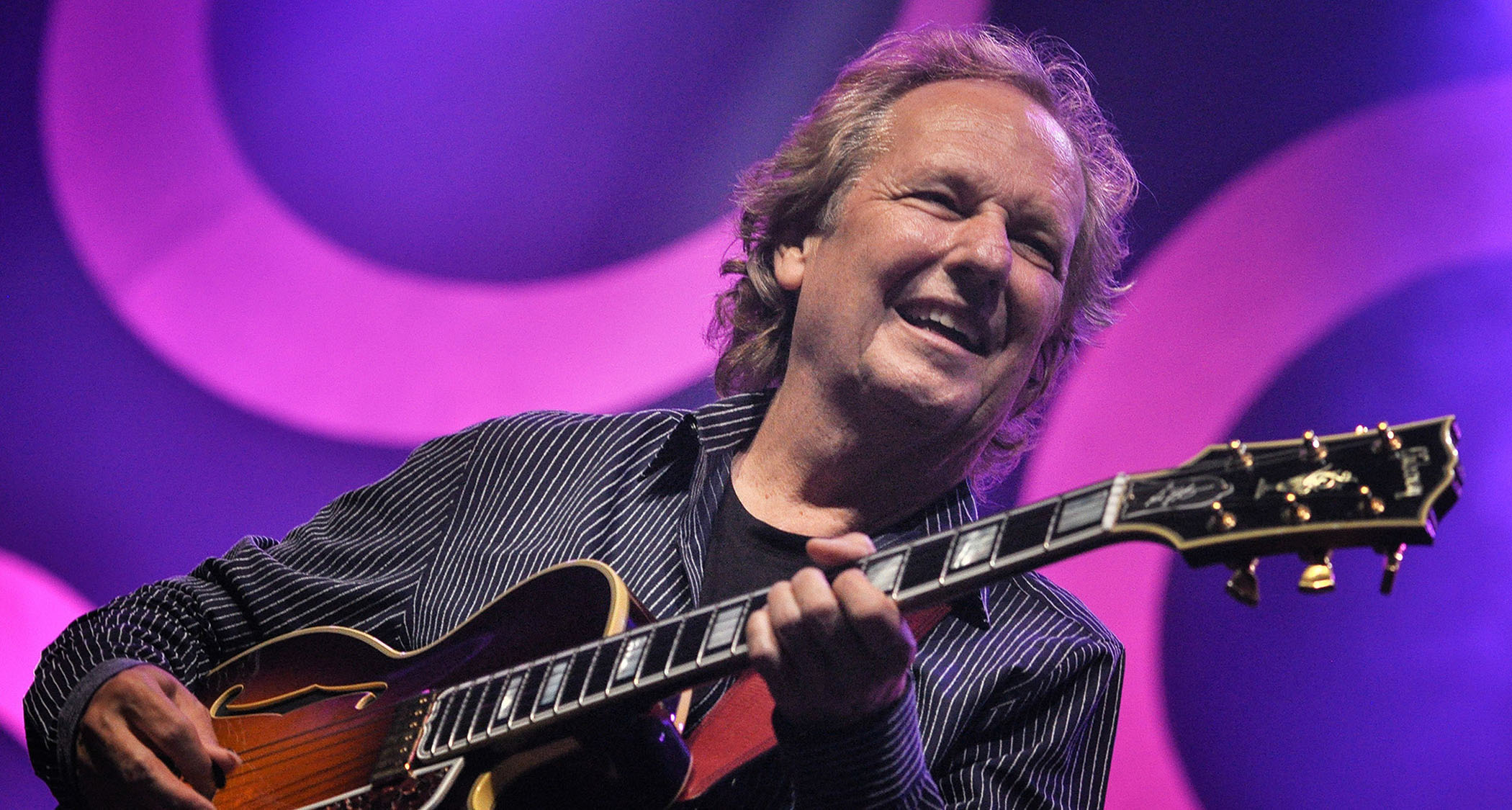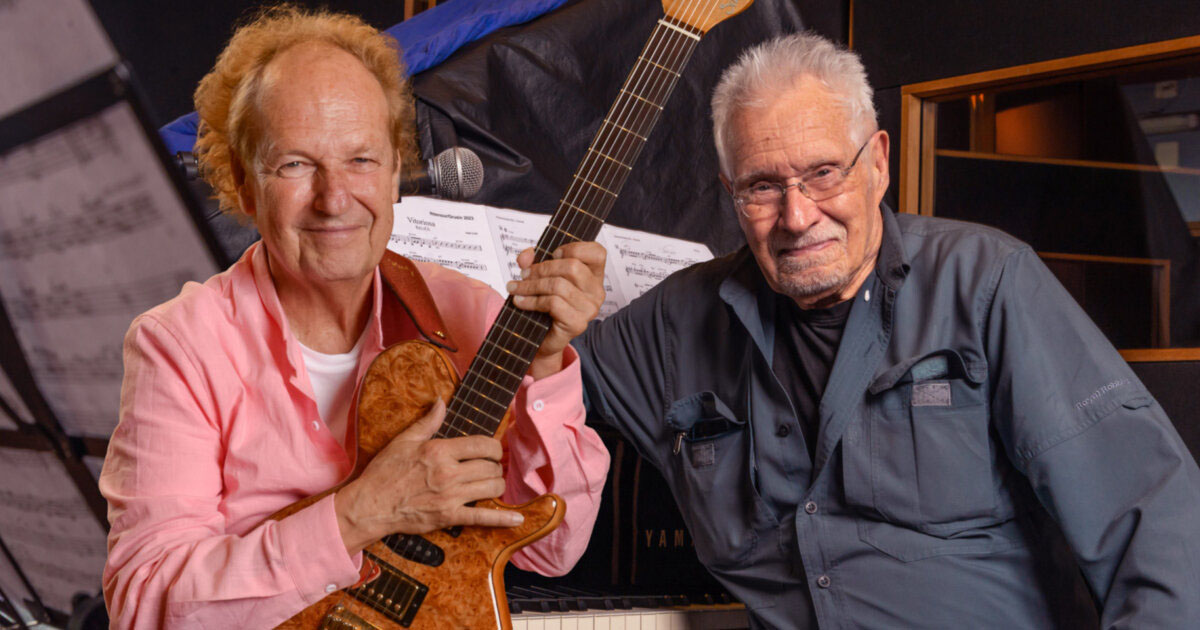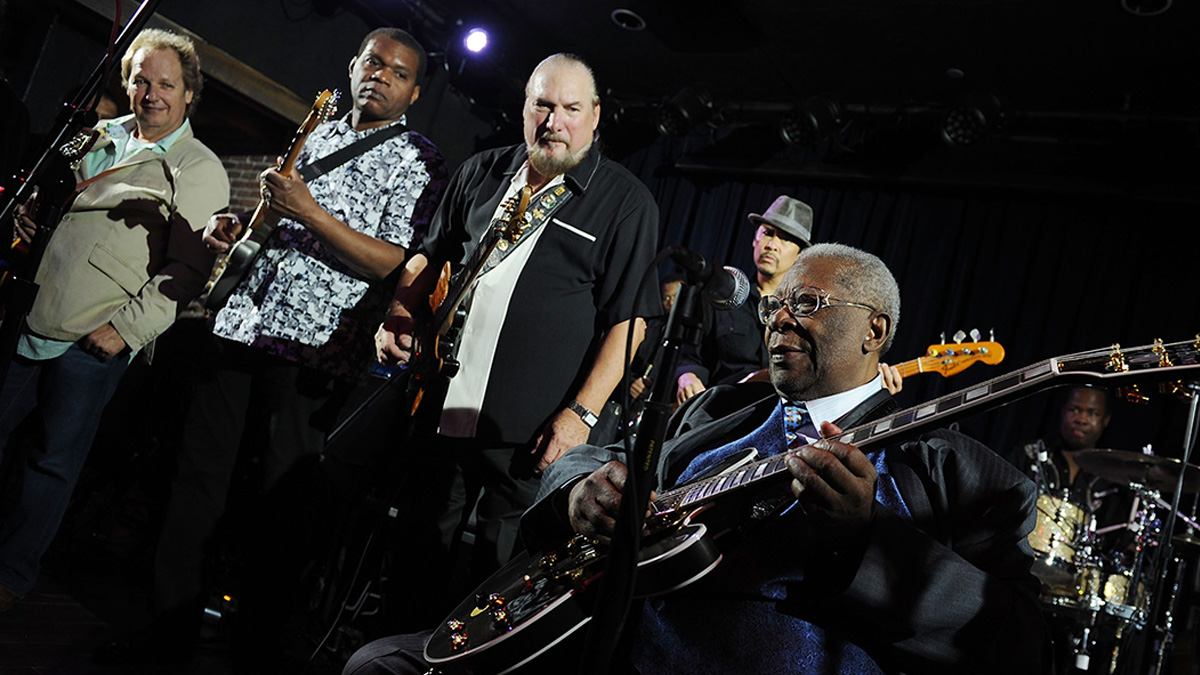
Lee Ritenour is a miraculous guitar player. His discography bears testimony to this. Back in the day as a first-call session player, Ritenour played on The Wall with Pink Floyd. He played with Aretha Franklin, Steely Dan, the Bee Gees, Stevie Wonder, BB King… The list goes on.
And along the way, miracles would happen – would be part of the day job – and the tracks he played on would become embedded in popular culture. On some occasions, Ritenour would even save the day, like that one time in 1980 when he answered a late-night call from Quincy Jones, raced into the studio and saved George Benson’s Give Me The Night guitar solo.
But the biggest miracle of all is that he managed to leave the session game – his “college education” – to embark on a stellar solo career that applied jazz guitar to different styles and sounds. That’s a rare feat, and it has brought us here, with Ritenour about to release, Brasil, his latest studio album with long-standing collaborator Dave Grusin.
It is an album that finds him celebrating Brazilian music and doing what he always wanted to do in the first place, following his musical curiosity, seeing where it takes him. On 22 July, it’ll take him and Grusin back to Ronnie Scott’s, in London. Grusin and Ritenour’s live band includes vocalist Tatiana Parra, bass player Anir Hassan, Wesley Ritenour on drums, and the Swiss jazz harmonica player Gregoire Maret.
“I am a huge fan of Ronnie Scott’s. The room, the audience, the people who work there, the history of Ronnie Scott’s, I can’t say enough about it,” he says. “It enables me and and in this case Dave Grusin to come back often and present in London an intimate dialogue with the audience – who are right in your face. They are right there, right up close.”
And this he says makes things interesting. Checking in from the studio in Los Angeles, Ritenour says we can expect the unexpected from these shows. Improvisation is part of the deal. But where does it come from? How can a player develop those skills, where in the moment they can stretch out in a jam?
In the conversation that follow, Ritenour says it goes back to songwriting. It’s not just about learning the vocabulary, the right chord, the right techniques, learning from your heroes, it’s about musical identity. And once you find yours, you can tie all different styles together and still sound like you. Here he discusses the benefit of a classical musical education, the mercurial nature of songwriting, and recalls that one time when BB King let him play Lucille.
When you are in a place that’s as intimate as Ronnie’s, is there a sense that the audience influences where you take the jam, how much you improvise?
“Well, definitely with our group! Because even if I am playing familiar tunes that I’ve played year after year after year, we never play them quite the same! [Laughs] And I will change the improvisation, the jam, the intensity of it, the style of it, whether it gets a little more sweet-sounding or a little more aggressive on any particular tune.
“The audience and the energy of the audience in Ronnie Scott’s definitely is a factor. Plus, the people who go to Ronnie’s, they see some of the finest musicians in the world there, and so they expect the musicians to stretch out. And in a way they push the musicians in the same way as the musicians are pushing the audience.”

Even after you record these songs they are still a living, breathing thing that can change when you play live.
“Absolutely, and so many times today – and it’s probably been that way a little bit historically – a lot of pop and contemporary music, R&B music, hit songs, and even some of the more, let’s say, pop-jazz artists that have gotten popular over the years in the instrumental field, play the songs closer to the record version.
Where the song goes, and where we twist and bend it, that’s what keeps it fresh for me. I think for Dave, too
“And my audience, and Dave Grusin’s, knows that they might be hearing a familiar song and the first few strains of the song might be close to the original, but then after that all bets are off. Where the song goes, and where we twist and bend it, that’s what keeps it fresh for me. I think for Dave, too.
“The fact that we can play some older material that we might have been playing for decades but each time it’s going to have a slightly different twist, [depending upon] the room that we are playing in, the sound of our instruments, the sound of the stage, the audience. The nice thing about Ronnie’s is it is a fundamentally incredible sounding room, and it sounds good with no people in there, when you are soundchecking. But when the folks get in there it is almost like a recording studio.”

How much an influence is the vocalist when you are playing. Because throughout your career, you have played with so many great vocalists, is that something you have in your mind, how the phrase things, and how you might phrase a lick on the guitar to go with that?
“Certain kinds of vocal tunes are more locked in than others. Years ago, when I had a pop hit with that song Is It You, my friend, Eric Tagg, sang the lead on it, and Bill Champlin sang the backgrounds, and David Foster was on keys along with Abraham Laboriel and Alex Acuña in the rhythm section.
“It was a very structured, pop/R&B song, and it was a hit. It was a big hit around the world. I think it was a Top 10, Top 15 hit here in the US. And as I performed it, it helped grow my audience and I was invited to bigger festivals, but I found that particular tune a hard tune to expand, to do it any differently than they way it was originally designed.
You never know where the inspiration’s gonna come from. Sometimes it is just hard work in the studio, and you can’t get from letter A to Letter B to letter C and connect the dots
“The way it was originally designed, with the parts that I came up with, David Foster came up with, the rhythm section and the vocalist, and the actual melody and harmony, the song was so well-crafted but it didn’t allow itself for expansion.
“On the other hand, some other tunes, like one of my Brazilian pieces, when we worked with João Bosco, the great Brazilian singer and guitarist, in 1988 on a song called Latin Lovers, that tune is a driving samba and when we would play that, that vehicle was easily expandable and changeable from night to night.
“So it really depends on the material, and of course the vocalist has to be able to sing the melody and the words, so right off the bat you’re a little more locked in, but certain singers can expand the style of the songs.”
Is It You was historic. Wasn’t that played on MTV’s first ever day of broadcast?
“That’s right! [Laughs] I forgot that. That’s right, yeah!”
Maybe it presaged this culture of locking things in on tape and that’s how things are. It’s strange. Songs have their own physical laws that are hard to fight against.
“That’s right, and it’s interesting, as we will be performing the Brazilian album there is a Milton Nascimento tune off the Cravo e Canela (Cloves And Cinnamon) and it features Tatiana Parra, Dave and I, and a great Brazilian rhythm section.
“We will be sticking to the melody with the harmonica and the guitar and the vocal, doing the song pretty much close to how the record was. But in the middle of the song it has much more room to expand for extending the song. So, again, that is an example of a song that has a bit more flexibility.”
The songwriting process is always fascinating. A while ago, you said that you wrote on the bicycle? Is that true, and if so, is it that sense of movement that gets the ideas moving? How did Brasil come together?
“This one varied a little bit. As you were saying, that song, LA By Bike, that I play many times. I still play that song often. That melody and that little lick, the vamp on that song, was bouncing around in my head while I was riding a bike, so that’s how that came about. And sometimes I would have another composition that would have nothing to do with the bike but I would have it in my head, I would go out on a bike ride and it would still be buzzing around in my head.
For The Palms came to me almost in one breathe, in one sentence, and when that happens you realise the power of music
“This particular album, I don’t remember taking a bike ride while I was working on the album but there was one other example, I think it’s the second track on the new album, called For The Palms, and Dave and I have already performed that live. We may have already performed that at Ronnie Scott’s.
“There’s a beautiful version of that on the new album coming out. It’s a jazz-waltz ballad and I wrote it while I was laying down on a chaise lounge outside, looking up at some palm trees that were going to have to be cut down because of the new fire regulations.”

“A few years ago, we had lost our house in Malibu, in the fire, and it was a very serious fire, and the city was being very strict about the palm trees. My wife was very upset about it, having to lose more palm trees – and these were big, very beautiful palm trees – and we had to cut a number of them down because of the new rules.
“So while she was crying the blues and really sad, I wrote this song, laying down with a guitar on my lap! [Laughs] On the chaise longue, outside, moaning about the palm trees, and this song came to me almost in one breathe, in one sentence, and when that happens you realise the power of music.”
There is something wonderfully epicurean about the creative process. Sometimes it is just a smell, the sap in the air, and it sets ideas off.
“Yeah, exactly. You never know where the inspiration’s gonna come from. Sometimes it is just hard work in the studio, and you can’t get from letter A to Letter B to letter C and connect the dots, and you write a million versions and the song is very complicated to write.
“It may not be a difficult song but the process sometimes is difficult. Then at other times with songwriting it comes out with on breathe, in five minutes, and you go, ‘Where did that come from!?’ [Laughs]”
You have always mixed different styles so well, and yet you started on classical guitar. How far apart are classical styles and jazz – is it a question of sensibility, that the classical training gives you the tools, the vocabulary for the latter?
“For classically trained musicians like myself and Dave Grusin, classical music is at the root of everything that we do. Your training may have started with classical music, and if it didn’t start with classical music, even if it started out with playing pop tunes on the piano, or you started out learning jazz first, the better musicians would usually dip into classical at some point.
I also studied with a classical piano teacher who taught me the piano but was examining the way the famous classical musicians wrote their music, and that was an education that was probably as helpful for me in the long run as anything I’ve done
“In my case, I studied quite a bit of classical guitar, and also loved it and appreciated it. And I also studied with a classical piano teacher who taught me the piano but was examining the way the famous classical musicians wrote their music, and that was an education that was probably as helpful for me in the long run as anything I’ve done.
“I grew up in a period with the electric guitar and jazz guitar, and blues guitar and rock guitar, folk guitar and country guitar, all the styles, [and] I ended up as a studio musician and was just a lover of the guitar, and could dip into it and appreciate the way Glen Campbell could play guitar or Django Reinhardt, or Segovia, Julian Bream, Jimi Hendrix, Wes Montgomery or Kenny Burrell. I appreciated everybody who could play the guitar well.”
There’s often not that much distance between these styles. Julian Lage was telling us that there is often not really that much between a rock ’n’ roll lick and a jazz lick, it’s more the attitude that you play them with.
“Absolutely. And the crazy thing about the guitar is that people play it upside down. They play it on laps. It’s like, Hendrix played it over his neck. Ha! It’s like, when you play the trumpet there is a right technique and a wrong technique, blowing into the instrument and there’s one way to get the note out.
“On the guitar, there’s a zillion [ways]. There are different ways of picking and strumming. The guitar is such a – and I say this in a loving way – but the guitar is such a bastard instrument! [Laughs] You can play it anyway that you can play it, and that’s what makes it so beautiful.
I say this in a loving way – but the guitar is such a bastard instrument! You can play it anyway that you can play it, and that’s what makes it so beautiful
“Somebody asked me [about that] the other day, because they know how many different styles my records have dipped into and yet it still sounds like a Lee Ritenour record, and now when you pull up Lee Ritenour Radio on streaming, whether it’s Spotify, Pandora or Apple Music, when you pull up Lee Ritenour Radio, and you hear all this variety of music, it actually works pretty well because now you don’t hear just one linear idea of an artist; you hear the breadth of the different stuff that I was able to do, and pull off, so I that aspect is kinda cool.”
What would your advice be for any player who wants to develop their improvisation skills?
“Well, that has changed with time. So for instance, the way Joe Pass, the great jazz guitarist, learned how to improvise was one way. The way Wes Montgomery did it was another way. But related. The way John McLaughlin did it in the fusion days was yet another way. And today’s young people – whether it is a Julian Lage or other even younger people than him – everybody has YouTube now, so you can watch and copy every musician on the planet.
Work on ideas, get beats and everything, and if you keep writing the songs it also helps identify who you are
“The guitar is such a visual instrument. You can see the right hand. You can see the left hand. And you know the six strings are tuned are certain way, and you can watch the YouTube video and so many people can copy other players. The hard part is not learning the vocabulary; the vocabulary you can copy and learn now. You’re copying Ritenour, Pat Metheny , Joe Pass or Julian Bream, or Jimi Hendrix – the material is out there.
“You can watch these guys and slow it down and they have apps on the phone where you can isolate a lick and play it still in the right key but play it really slowly and learn. That’s the way a lot of the young musicians are learning these days. The problem with that is that you still have to learn how to become an individual, and you learn how to have your style.
“I think that’s also where songwriting, writing your own songs, [is important]. Because you can copy – you can write a song like a Lee Ritenour song. You can copy from a Pat Metheny song. But if you are really honest with yourself, you can try to search for ideas by singing, or by playing your instrument, or the piano, and putting them on Pro Tools or Logic, and work on ideas, get beats and everything, and if you keep writing the songs it also helps identify who you are.”
What was the biggest lesson you learned from being a studio musician? And in those scenarios, would you learn more from working with the producer or with the artist themselves?
“Hmm, well that’s a great question. Back in the early days, when I was first making my records, and even before that, doing studio work, it was great to work with producers and artists that I respected. I also ended up working with a lot of artists that I thought knew what they were doing and then found out that they didn’t really.
“Some of them were just searching all the time for the right thing, and I ended up appreciating that. Sometimes they didn’t know how to get there but they kept searching through the studio musicians, finding the right beat, the right way to form the song, and I would appreciate that.”
“I’ve done several interviews about working on The Wall with Pink Floyd, and they were just incredible musicians, the way they would keep searching to make the records. Steely Dan was the same way. The Bee Gees, those earlier records, were the same way. Of course, then there were the unbelievable talents like Stevie Wonder. God-given talents. Anything they did was just beyond everyone else.
Pink Floyd were just incredible musicians, the way they would keep searching to make the records. Steely Dan was the same way. The Bee Gees, those earlier records, were the same way
“But to answer your question. It was like going to school and sometimes you would disagree with the teacher and the professor about what they were teaching. And you would say to yourself, ‘Those guys are full of shit. They don’t know what they are talking about.’ You would have that experience, and then on the other hand, I would sometimes work with producers, musicians and artists that were just so phenomenal you just wanted to spend more time with them and appreciated their journey.
“And it was on record days, it was on jingles, TV shows, movie dates – it was an incredible education being a studio musician, and I am glad I graduated because I really wanted to have my own career and make my own records. I could have easily just stuck it out and stayed a studio musician but I wouldn’t have been happy. I call it my college education. [Laughs]”
And what an education! You spent some time with BB King in the studio. What was that like? Was he more a live player than a studio player?
“Well, BB was just incredible, his whole life. I can’t say enough about BB First of all he had that style, and that personality with his music that transcended everybody – and of course he travelled the world.
“He loved being at the festivals, whether it was Montreaux or North Sea or wherever he was playing, or in Japan or the US at the Playboy Jazz Festival. If he was performing and we were performing before him, he would ask a number of guitar players to come out and play with him, and so I would.
“On the records, I would sometimes play rhythm guitar, and I got to know his crew. BB was incredibly strong on guitar. He had this incredible vibrato that nobody on the entire planet could play vibrato on the guitar like he did.
BB was incredibly strong on guitar. He had this incredible vibrato that nobody on the entire planet could play vibrato on the guitar like he did
“I was at a festival with him. I had performed with my band and opened for him. I forget where this was. After my performance he went on, and he was on his encore, and he put his guitar down on the stand and he was just singing. He saw me standing by the curtain there, offstage, and he shouts, ‘Lee, come on out!’ And he says to the audience, ‘Lee Ritenour! Come on out!’ [Laughs] I said, ‘I can’t, BB, my guitar’s all packed up. I don’t have my stuff.’ He said, ‘That’s okay, play mine.’
“I went onstage and I grabbed his guitar. First of all, I put the strap on and the guitar was down to me knees, right!? He was a big guy. So then I adjusted that, and then I tried to play his guitar… His guitar! The strings were off his Gibson guitar, like, I have never experienced anything like that. It was like piano strings, and it was so far off the neck, so high off the neck, and then there was all this built-in grease. It was BB King grease on the guitar that had been baked on there for years and the strings were heavy as hell.”

“I couldn’t physically play the guitar! [Laughs] And I tell this story because I was so blown away. He was so strong, and he had that vibrato. That’s why I remember this story, ‘cos he had this vibrato that is hard to do when you are playing a guitar like mine, that’s normally strung up. But on his guitar? He was something else. He was very special, and he loved sharing the stage with all the guitar players. He was just something else.”
- Brasil is available for pre-order and is released on 31 May via Candid.
- Lee Ritenour and Dave Grusin play Ronnie Scott's Jazz Club on 22 to 23 July. See Ronnie Scott's for tickets.



!["[T]he First and Fifth Amendments Require ICE to Provide Information About the Whereabouts of a Detained Person"](https://images.inkl.com/s3/publisher/cover/212/reason-cover.png?w=600)



